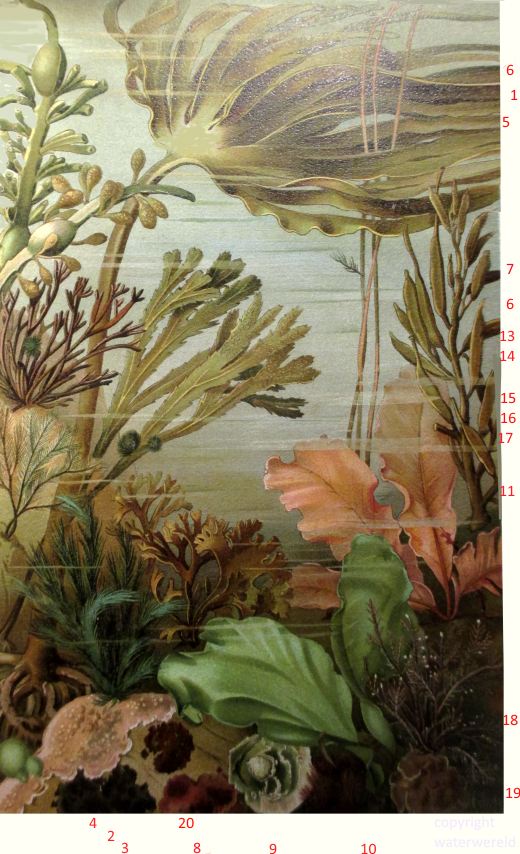Irish moss or Chondrus crispus
This is a small red algae that grows abundantly on the rocky coast of the Atlantic ocean. It can be found on rocks and in rock pools on the middle and lower shore. It remains rather small: up to 20 cm. Irish moss tolerates brackish water and is sometimes found in estuaries. Its appearance may vary depending on the exposure of the shore and the level at which it is growing on the shore.
growing from the bottum up
Irish moss grows from bottum up. This is an unique ability, giving the irish moss an advantage over other sea weeds: As waves crush the top of the irish moss, it will be renewed.

Seaweed around Helgoland, Northsea.
source: "Die Pflanzenwelt", dr Otto Warburg, 1903.
1 oarweed or Laminaria digitata
2 Lithothamnium Calcareum
3 Pseudolithoderma extensum
4 Tufted Sea Moss or Cladophora rupestris
5 rockweed, Norwegian kelp, knotted kelp or Ascophyllum nodosum
6 dead man's rope or sea lace or chorda filum
7 ectocarpus attached to the sea lace
8 Hildenbrandia rubra
9 Porphyra umbilicalis (this is the Conchocelis rosea, the diploid stage)
10 sea lettuce or ulva lactuca
11 Chaetopteris plumosa
12 Polyides lumbricalis var. fastigiatus
13 cladophora lanosa
14 Acrosiphonia arcta attached on cladophora lanosa
15 toothed wrack or serrated wrack or fucus serratus
16 Elachista fucicula attached on fucus serratus
17 Sea Beech or delesseria sanguinea
18 coral weed or corallina officinalis
19 Lithophyllum incrustans
20 Irish moss or carrageen moss or chondrus crispus
farming irish moss
Irish moss used to be the most important source of carragen . However, its share of the carragen industry has declined from 75% before 1975 to £ 8% at present, Carragen is now produced by Eucheuma in South east Asia.
harvesting irish moss
There are two ways of collecting: the first is done by hand : After a storm the waves and high winds washing moss into the more shallow areas where it will be collected using nets or rakes. The other way is by using small boats. Some drags are pulled over the sea bottom. Together with the Irish moss the false Irish moss is sometimes collected. Mastocarpus stellatus or false irish is able to coexist with C. crispus on the northern New England coast despite being a competitive inferior to C. crispus. But the false Irish moss is better frost resistent.
carrageenan
Carrageenan is the industry term for polysaccharides derived from Irish moss. It is extracted from the moss by heating, Carrageenan is used as a additiv in food and has many uses: the purified carageen is used as a thickening/gelling agent in many yellies, in fact it is a kind of gum. It is also used as an emulsifier in processed foods such as ice cream, cheese, deli meats, protein drinks and toothpastes. Emulsifing means: They help liquids to stay mixed together without separating. It is hard to find processed products that doesn't contain carrageenan.

Tidial plants of the North sea by B.E. Nicholson, 1905
1 flawed fork weed or Furcellaria lumbricalis
2 carragheen or false Irish moss or Mastocarpus stellatus
3 sea lettuce or Ulva lactuca
4 Monostroma grevillei
5 Golden seaweed or Laurencia obtusa
6 Irish moss or chondrus crispus
7 Peacock's Tail or Padina pavonia
8 Polyides rotundus